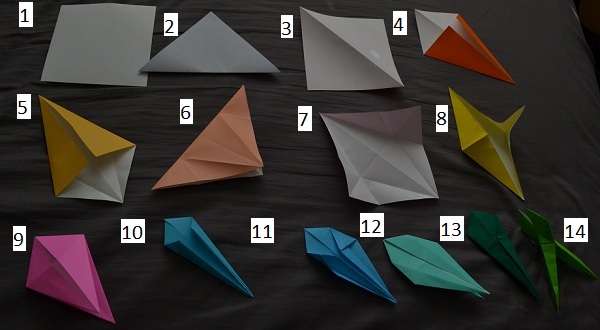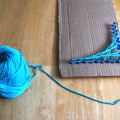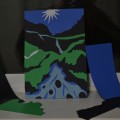Something about taking a piece of paper and making it into something else is inherently fascinating. It speaks to the infinite potential of the unformed, and the beauty of geometry. Either that, or it taps our nostalgia for Transformers.
One of the best things about origami is, paper is pretty easy to come by in almost every setting. Napkins, pamphlets, printers, post-it notes, you name it. Of course, you can also get special origami paper from a craft store, which typically has at least one color on one side and white on the other. It’s pre-cut into squares, and typically is a bit thinner than normal paper. Thin paper means that it can be folded more times without bursting or getting in the way later, which is an issue with advanced models.
Making a square yourself is relatively easy, just fold the top of a paper to the side like so:
Then fold the extra strip along the edge of the triangle, and cut/tear it off. You can also do the same to the little strip to get smaller squares, and so on until you start thinking like a Greek philosopher and pondering how small can you get something before it cannot be divided.
Now that you have your square, it’s time to get down to business.
SURVIVAL ORIGAMI
For those who are too cool to drink from the tap, or for when there aren’t any more cups at the watercooler, I give you the origami cup:
This is largely self-explanatory. Between 4 and 5, fold down one of the triangle flaps at the top. Between 5 and 6 flip it over and do the same thing. You get a nice little pouch, generally good for one or two uses. If you make it out of wax paper, it gains a significant amount of reusability.
MOVING ORIGAMI
I call it pliers, but it is only superficially similar to the tool in question. That doesn’t matter; kids and adults will be fascinated for at least five seconds, which is more than you can say about a lot of things.
It gets tricky around 8, where you fold along the creases you made earlier and are left with a rhombus with two fins sticking out. Then you fold it in half to get to 9. The progression from 10 to 11, where you open up the side flaps and squish the y-shaped joint into the triangle you see on the right side of 11. Take it slow, and don’t worry if it looks ugly; it’s a fiddly bit that takes time to master. Do the same for the other side and flip it over to get to 12. Fold along the creases to get to 13, bringing the edges of the flaps to the middle. 14 is another fiddly bit, where you fold along the center of the narrow triangles and pull them apart. This opens up the beak, and makes it a fully operational entertainment battlestation.
MAKE A WISH
According to Japanese legend, if you make a thousand paper cranes in one year, a crane will grant your wish. Or possibly give you really long life, the legend varies. Nevertheless, it is a gift that some people give each other for good luck and perhaps as a general expression of “thinking of you”. All things considered, it’s not so hard. Three cranes a day will get you to one thousand in a year easily.
This one gets tricky from 5 to 6. Basically, bring all the points together and fold along the creases you made earlier to make a diamond with four flaps. To get to 7, fold the open edge of each flap to the middle crease. Then in 8, fold the triangle on top of the two flaps. Unfold 7 and 8, and lift up the bottom corner. To get to 10, fold along the creases you just made, hinging on the one from 8. Then repeat 7-10 on the other side to get to 11. Fold the flap along the center crease like turning a page, and do the same for the other side to get to 12. Pull the side thing down and forward and squish it to get the head and neck parts sticking out right. Push the tip of the sticking out part down and reversing the fold to get the head. Then fold the wings up horizontal, and you have a crane.
If any of these instructions are hard to understand, please visit your local library or YouTube, and there will be many books/videos to help you out.
I got into origami because of a certain art teacher in elementary school who gave me a flapping crane. Since then, origami has been a comfort to me, and a simple thing to occupy my time. It is an odd skill, of common components, but rare occurrence. It teaches us that there is wonder yet in the mundane, if we will but use it in a new way. I have taught you how to wish, and now you can see miracles for the rest of your lives.
About Brandon Quist
Brandon is originally from Olmsted Falls, Ohio. He has studied both at Baldwin Wallace college and Brigham Young University, and is currently pursuing Chemical Engineering, among other things. He considers himself a jack of all trades, and a master of none. In his spare time, Brandon enjoys knitting, guitar, reading, origami, writing, and photography.











